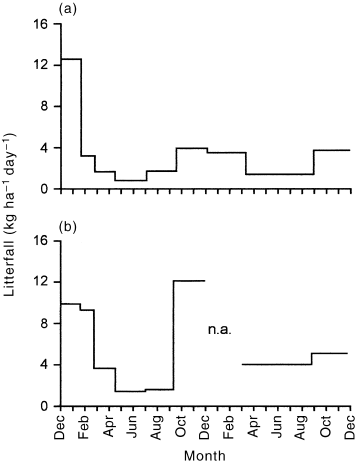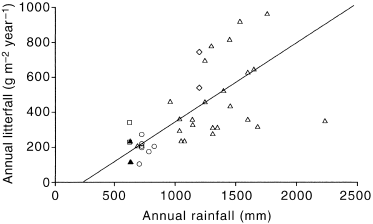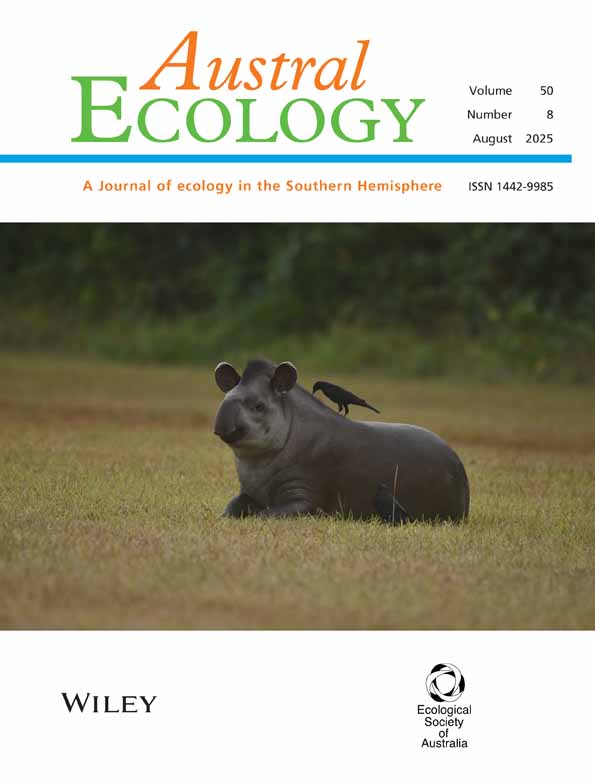Litterfall from two eucalypt woodlands in central Queensland
Abstract
The mean annual litterfall at two dry woodland sites in central Queensland was 1129 kg ha–1 for an open E. populnea F. Muell. woodland (n = 2 years), and 2318 kg ha–1 for a woodland dominated by E. cambageana Maiden (n = 1 year). Leaves formed the largest component of total litterfall, which varied seasonally with a spring–summer maximum. Annual litterfall at these sites conformed with a pattern of decreasing litter production with declining annual rainfall, consistent with a range of eucalypt-dominated communities.
INTRODUCTION
Net above-ground primary production, as approximated by litter production, is strongly related to the physical environment. Both Lieth (1973) and Bray & Gorham (1964) showed that temperature and rainfall were important controlling variables on a global scale. In contrast, Lonsdale (1988) found that latitude was a better predictor of litterfall for forests of the world, largely because this integrates mean annual temperature and rainfall. However, he noted that within a restricted latitudinal range, leaf litterfall was positively related to annual precipitation.
In elucidating similar patterns for eucalypt- dominated forests of Australia, there exists a reasonable amount of information on annual rates of litterfall in the more mesic regions ( O’Connell & Menagé 1982; Hutson & Veitch 1985). However, Bevege (1978) noted meagre availability of published data for semi-arid woodlands, reflecting a paucity of research in dryer eucalypt communities generally ( Lamb 1985; Parsons 1994). With the exception of the more recent work by Burrows & Burrows (1992), there remains a lack of comparative information on basic ecological function in these systems.
This note provides data on rates and content of litterfall from two eucalypt woodlands in central Queensland, in an area receiving approximately 630 mm annual rainfall. The aim is to extend our limited knowledge of these drier communities and provide confirmation of the impact of aridity on litterfall.
METHODS
Study sites
Two sites were selected from relatively undisturbed native communities within the lease areas of Saraji mine (22°24′S, 148°16′E) and Norwich Park mine (22°44′S, 148°28′E), both open-cut coal mines northwest of Rockhampton in central Queensland operated by BHP Coal (Brisbane, Queensland, Australia). The Saraji site was dominated by mature Eucalyptus populnea in the upper canopy, with Eucalyptus papuana as a less frequent subdominant. Tree density averaged 200 stems ha–1, with a basal area (at 30 cm) of 9.9 m2 ha–1. Canopy height was approximately 10–15 m. The shrub layer was absent except for sparsely scattered Grevillea striata, Cassia brewsteri and Eremophila mitchellii. The ground layer comprised mainly native grasses including Aristida spp., Bothriochloa spp., Digitaria spp. and Heteropogon contortus. The soil was a solodized solonetz.
The site at Norwich Park contained an overstorey dominated by Eucalyptus cambageana to a height of approximately 10 m, with occasional Casuarina cristata and Terminalia oblongata. Regrowth Acacia harpophylla, presumably from thinning activities prior to the establishment of the mine, formed a mid- to lower storey of 2–4 m in height. Densities of stems (≥2 cm diameter) were in the range 800–3200 stems ha–1, with more than 90% of the total density consisting of A. harpophylla. Projective foliage cover of the canopy was estimated at 50–60%. The ground layer contained occasional Carissa ovata and sparse brigalow grasses, including Paspalidum caespitosum and Panicum subxerophyllum. The soil was a brown cracking clay with obvious gilgai, but graded to a solodized solonetz at one end of the site.
Both sites, approximately 50 km apart, experience a subhumid, subtropical climate, with hot summers and mild winters. Rainfall is summer dominant, often associated with thunderstorms or cyclonic activity. Long-term (1956–96 data) average annual rainfall at Saraji, for which reliable records exist, is 626 mm. However, below-average rainfall was experienced at both sites over the period of study.
Litter sampling
Litterfall was collected in square, timber-framed traps (area 0.345 m2 with sides 0.15 m deep) with a fine mesh base, supported approximately 0.15 m above the ground by four steel pegs. Each site of approximately 1 ha in area was divided into 10 m × 10 m cells, with a trap placed at the centre of 20 randomly chosen cells. Litter was cleared from the traps at intervals of 5–11 weeks from December 1993 to December 1994, and then on three occasions to December 1995. In all except the final two collections, material was sorted into leaves, twigs (≤2 cm) and bark, reproductive parts (buds, flowers, fruit and seed) and miscellaneous unidentified fragments. The leaf fraction at Norwich Park was further separated by species. Fractions were oven-dried (80°C, 48 h) and weighed.
RESULTS
Total litterfall at the Norwich Park site was higher than at Saraji ( Table 1), consistent with a higher density of trees and the presence of a midstorey. The contribution of the leaf and twig/bark fractions to total litterfall was similar at both sites, with leaves forming the greatest proportion. Of total leaf fall in 1994 at Norwich Park, 44% was from E. cambageana, with 28% from C. cristata and 24% from A. harpophylla.
| Year | Component | Litterfall (kg ha–1) | |
|---|---|---|---|
| Saraji | Norwich Park | ||
| 1994 | Leaves | 743 (41) | 1364 (302) |
| Twigs and bark | 468 (170) | 874 (262) | |
| Reproductive parts | 106 (16) | 6 (2) | |
| Miscellaneous | 42 (5) | 74 (14) | |
| Total | 1358 (189) | 2318 (386) | |
| 1995 | Total | 900 (66) | n.a. |
- n.a., missing data.
The expected seasonal pattern of litterfall was evident at both sites ( Fig. 1). Total litterfalls were maximum in the spring and summer months, which accounted for approximately 80% of the total both in 1994 (January, February and December collections) and in 1995 (March and December collections). At Saraji, variation in total litterfall largely reflected changes in rates of leaf fall, with twigs and bark falling fairly consistently through the year. At this site, the mass of reproductive material was highest in collections from October to early January. At Norwich Park, proportions of leaves and twigs/bark varied throughout the year.

Average daily rates of total litterfall in (a) a Eucalyptus populnea woodland, and (b) a Eucalyptus cambageana–Acacia harpophylla woodland in central Queensland from December 1993 to December 1995. n.a., missing data.
DISCUSSION
Litterfalls in this study were similar to those of Burrows & Burrows (1992), who reported rates of 920–2730 kg ha–1 year–1 for various eucalypt communities in central Queensland, and rates of 920–1800 kg ha–1 year–1 for woodlands dominated by E. populnea. Hutson (1985) found mean annual rates of 1140–2050 kg ha–1 year–1 in Eucalyptus obliqua–Eucalyptus baxteri low open forest sites in South Australia with average annual rainfall up to 690 mm. Leaves usually form the largest component of litterfall in most eucalypt communities (e.g. McColl 1966; Rogers & Westman 1977; Birk 1979; Hutson 1985). The size of the bark fraction is dependent on bark type, and is generally low for eucalypts with flaky or fibrous bark ( Rogers & Westman 1977; Pressland 1982; Lamb 1985), as was the case for the two main eucalypt species in this study. The seasonal nature of litterfall is also in accord with other studies, with higher litterfall in the spring and summer months being linked to increased temperature and solar radiation ( Attiwill et al. 1978 ; Pressland 1982). Burrows & Burrows (1992) also note that moisture stress, caused by low infiltration and moisture-holding capacity in duplex soils, may also result in increased defoliation.
Litterfall rates in relation to annual rainfall at the two sites are consistent with the trend for decreasing litterfall in eucalypt communities with increasing aridity ( Fig. 2), reflecting a decline in overall community productivity ( Bray & Gorham 1964). Interestingly, the regression indicates zero litterfall in areas of 230 mm annual rainfall, coinciding approximately with the lower limit for eucalypt-dominated communities ( Parsons 1994). Rainfall, however, was only able to explain part of the variation (R2 = 0.49), with measurement errors and other factors, including temperature, nutrient availability and species composition, all contributing to the scatter ( Lonsdale 1988).

Relationship between litterfall and rainfall for eucalypt-dominated communities in Australia. Data are from this study (▴), Hutson & Veitch (1985) (▵), Lamb (1985) (◆), Burrows & Burrows (1992) (○), and Hart (1995) (□). Rainfall data have been estimated by interpolation from nearby centres for sites where this was not provided in the reference. The regression, omitting the outlier above 2000 mm annual rainfall, is given by the equation y = –104 + 0.45x (R2 = 0.49, P < 0.001).
Acknowledgements
This work was conducted as part of a study of nutrient cycling in rehabilitated communities following open-cut coal mining. Financial assistance was provided by a grant from the Special Research Program of BHP Coal.
The study was supported by an Australian Postgraduate Research Award to the senior author (AHG).
We appreciate the co-operation of Rod Cameron and Stan Roser, formerly of Saraji mine, and Peter Baker, formerly of Norwich Park mine. Steve Bray, Maria McMaster, David Stafford and Simon Cramp assisted with field collections.




